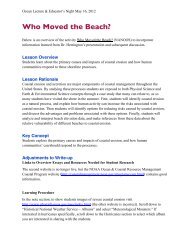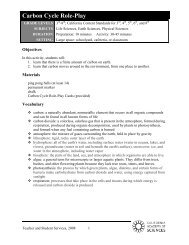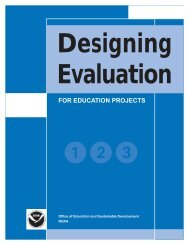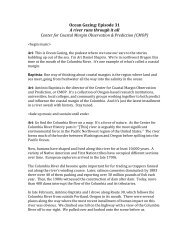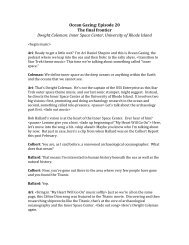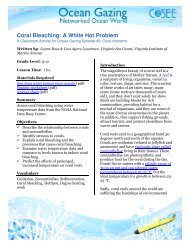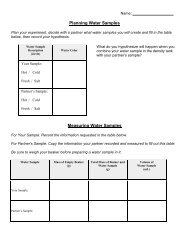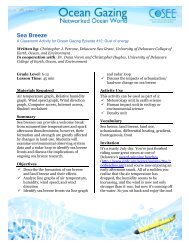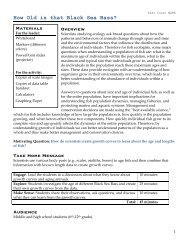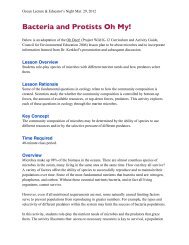You also want an ePaper? Increase the reach of your titles
YUMPU automatically turns print PDFs into web optimized ePapers that Google loves.
Ocean Gazing: Episode 32A Cook at seaTeacher at SeaAri: This is Ocean Gazing, the podcast where we trans<strong>for</strong>m the ocean into an underwatertheater, and pull up front-row seats. I’m Ari Daniel Shapiro. Okay, guess which of the 50states this is.Cook: We have lots of rice fields. It’s also the world headquarters <strong>for</strong> duck hunting, internationalheadquarters <strong>for</strong> Walmart, we’re number one in chicken production. I think we’re the only state in theunion that has a diamond <strong>min</strong>e.Ari: Answer? Arkansas. Mary Cook teaches seventh and eighth grade science at AhlfJunior High School in Searcy, Arkansas, about an hour, hour-and-a-half outside LittleRock.Cook: Arkansas used to be called the land of opportunity because of all these opportunities: the chickens,the rice, the diamonds. But I think it’s still the land of opportunity.Ari: Her students think so too. Listen to Mary Cook’s story, and you’ll see why. Staytuned.Ari: Most of the people that are interviewed come from the coasts. So I’m wondering: how did someonelike you, from Arkansas, get engaged in ocean science?Cook: Okay, I’ve been teaching Earth Science <strong>for</strong> about 25 years. I’ve always found it difficult to teachmy students - who most of them are around 13 years old - about the ocean because most of them have notbeen to the ocean. And so I’ve always been looking <strong>for</strong> ways to make it more personable.Ari: Mary Cook came across a program called Teacher at Sea. It’s run by NOAA - theNational Oceanic and Atmospheric Ad<strong>min</strong>istration. And it gives teachers - fromkindergarten teachers to college-level teachers - the chance to board a NOAA researchcruise and work side-by-side with scientists and crew to learn about and help do thescience. Cook read through the different cruises that were available.Cook: There was one particular voyage that was going to be looking at climate and climate change andgathering data and deploying buoys on tsunamis. And those were things that I teach. And so I justthought, “Okay, I’ll apply <strong>for</strong> it. Maybe they’ll pick me, maybe they won’t.”Ari: They did pick her and just like that - Cook’s dream gave way to the reality of gettingready to go to sea <strong>for</strong> 3 weeks far off the coast of Chile. The chief scientist <strong>for</strong> the cruisewas going to be Bob Weller, a physical oceanographer from the Woods Hole
Oceanographic Institution. Cook got her principal’s approval to participate. She found asubstitute teacher. But all this turned out to be the easy part.Cook: Be<strong>for</strong>e I left, I was really, really worried. I knew I would love the science. I mean I didn’t worryabout that. I was worried that I would be on that ship, and want to get off. I began to view it kind oflike a prison. But I’m kind of a person that if I’m afraid of something, then I’m just gonna go ahead andmake myself go through with it because I want to conquer that. But it didn’t take long after I was on theship and we were out to sea to realize that I never, ever felt like it was a prison at all. When you can’tsee any land <strong>for</strong> three weeks, it’s kind of liberating to just look at sky and water.Ari: And every day, Cook wrote a blog with stories and pictures <strong>for</strong> her students. She toldthem about how the science team was studying the Earth’s climate by using buoys anddrifters and probes to measure the ocean and the atmosphere. Her students emailed herback. And Cook was sure to let them k<strong>now</strong> when the buoy they’d adopted as a class wasreleased into the ocean to track the temperature and pressure of a particular current. It wasthis buoy more than anything else that caused her students’ interest to skyrocket.Cook: They signed these stickers, and then I took the stickers with me. And when I got to the ship and tothe little buoy, I put all their stickers on. Then I took pictures, and I posted them on the Internet. Theinterest in ocean currents quadrupled among my students because of that. And so they knew: that wastheir adopted buoy.Ari: I was reading your reflections on your Teacher at Sea experience, and at one point you say that eventhough the Teacher at Sea cruise took place a few years ago, it continues to be THE potent <strong>for</strong>ce in myapproach to teaching my students about oceanic and atmospheric sciences today. I’m just wondering,why?Cook: Because it’s so personal. And I think if you can make it more personal <strong>for</strong> the teacher and thestudents, they’re going to remember it. I’ve talked to those students that I had five years ago. And one ofthem, I saw him a couple of weeks ago. And he was talking about his graduation night. He wore hisNOAA pin on his graduation gown. So to me, it made a great impact on them. It’s so personal to me,and I learned so much. I mean, I had read about research but <strong>now</strong> I k<strong>now</strong> about it. And I’ve participatedin it.Ari: At Ahlf Junior High, Cook’s current students agree.Brett Blasco is one. He’s in the eighth grade. Be<strong>for</strong>e moving to Arkansas, he grew up onthe ocean in Washington state.Blasco: I enjoy the ocean. In the summer, cause my dad lives in Cali<strong>for</strong>nia so we go to the ocean, swim.Ari: So does the fact that Miss Cook went on this trip, and was one of the first teachers ever to go out tosea, does that make her kind of extra cool?Blasco: Yeah, I think it helps because it shows that she’s been there. She k<strong>now</strong>s what it’s like. It’s moreinteresting to look at and get more into.Ari: Emily Rollins is also in the eighth grade. She’s from Searcy, Arkansas, but Rollinshas gotten to see the ocean on vacation in Mexico. Studying the ocean is her favorite partof science class.Rollins: Yeah.
Ari: Why do you say it’s your favorite subject?Rollins: Because I’ve always liked, you k<strong>now</strong>, being near water and around the ocean. I think it’s veryinteresting how, you k<strong>now</strong>, the ocean affects our climate.Ari: Do you actually see that in Arkansas?Rollins: Yes, because when Louisiana has its hurricane season, we kind of get sort of the aftermath:what was leftover from that up here. But mostly it comes in real heavy rains or tornadoes. Even thoughArkansas isn’t touching the ocean anywhere, it still affects us.Ari: You think you wanna do something with the oceans in the future?Rollins: Well, the thing I would like to learn to do with the ocean is to learn about the marine life thatlives there. And I thought that would be a good option <strong>for</strong> the future.Ari: So if you could have one wish about the ocean, what would that be?Rollins: If I could constantly live there <strong>for</strong>ever cause I love being there. It’s kinda like being surroundedby a whole different world.Ari: The beauty of the Teacher at Sea program is it lets the students in a classroom touchthat different world. Help them feel connected to the ocean in a way that’s lasting andmeaningful. The program’s been around since 1990, and more than 500 teachers fromacross the country have participated. If Mary Cook’s experience is any indication, it canreally lead to a…sea change in how teachers and students alike relate to the ocean.Cook: Right, cause it opened a lot of doors in that respect <strong>for</strong> me. So <strong>now</strong> when I’m looking <strong>for</strong> lessons,it means something to me when I see it. And I can also turn around and explain that to my students.Ari: Now that you’ve been on the sea and have actually gotten to k<strong>now</strong> the ocean in a very intimate way,I’m wondering if you can describe what your relationship is with the ocean, you k<strong>now</strong>, personally?Cook: Some of my impressions of the ocean was how big it was. I was just overwhelmed at its depth.Something I do remember is thinking that the ocean felt like it was breathing cause it has this constantswaying or moving. It was kind of a com<strong>for</strong>ting feeling. Instead of being afraid, I felt com<strong>for</strong>ted by itAri: This was last week’s sonic stumper. It’s Arkansas’ statesong, called “Oh, Arkansas.” Maybe they should add justone more line. It’s the spirit of the ocean. Here’s our new sonic stumper. Okay, what we’re listening to isa type of recreational activity. Can you name what it is?Sail over to our website, oceangazing.org, to see photos of Mary Cook at sea and of herstudents. You can also find a link to a beautiful children’s book that Cook co-authoredabout her voyage on the high seas. Let her k<strong>now</strong> what you think of her Teacher at Sea tripby posting a message on our blog! Oceangazing.org.
Special thanks to Patricia White, and to Jacki Romey, Matt Price, and Blake Gladden atSearcy High School who recorded the Arkansas audio. Ocean Gazing gets financialsupport from the National Science Foundation. This podcast is a product of COSEE.



